Sound Capture for Film
Capturing sound for film is different when outside than recording in a studio, like voice over, where the set up would be similar to music production. We got to try a number of different microphones that would synch up with the video we were recording. If we were not using a cable to connect the sound to the video feed a Clapper board or a strong click could be used to create a peak in the signal allowing an easier sync up in editing. We were left to do some experiments with the Boom microphone set up to see what it would be like with the portable box and the boom pole noting that a microphone cover or dead cat could be placed on top of it to reduce noise from popping and plosives and also wind. The Boom mic had a small field of sound pick up possibly a hyper cardioid pattern that required careful control over the direction it faced.
Shot Gun Microphone
We got to use a Shotgun microphone mounted upon the camera's head first and then we incorporated it with the boom to see how that can be utilised with film sound. The audio we collected from this was mono but had better quality and a tight direction cutting out most of the sound behind the camera.
Shotgun Mic from Conker on Vimeo.
Zoom Microphone
The Zoom microphone is a portable machine with two microphones crossed on top to collect a stereo signal. We first recorded separately with the Zoom mic which gave us a soundless video feed and then a audio file on the Zoom's memory card. Then we recorded with the set up hooked into the camera to record both at the same time. Both of the audio from the Zoom mic had good to very good pick up of sound if the quality was less than the Shotgun mic. Its good pick up and portability would make it great for ambient sound or for stereo interview. With film it would be good for hand held and on location uses.
Zoom Mic from Conker on Vimeo.
Shot Gun Microphone
We got to use a Shotgun microphone mounted upon the camera's head first and then we incorporated it with the boom to see how that can be utilised with film sound. The audio we collected from this was mono but had better quality and a tight direction cutting out most of the sound behind the camera.
Shotgun Mic from Conker on Vimeo.
Zoom Microphone
The Zoom microphone is a portable machine with two microphones crossed on top to collect a stereo signal. We first recorded separately with the Zoom mic which gave us a soundless video feed and then a audio file on the Zoom's memory card. Then we recorded with the set up hooked into the camera to record both at the same time. Both of the audio from the Zoom mic had good to very good pick up of sound if the quality was less than the Shotgun mic. Its good pick up and portability would make it great for ambient sound or for stereo interview. With film it would be good for hand held and on location uses.
Zoom Mic from Conker on Vimeo.
























































